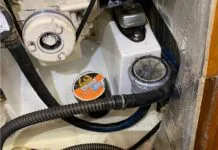You need only look at a couple photos in our report on anchor holding power in mud to recognize the advantages of a washdown pump. Installing a washdown pump is a project that any capable do-it-yourselfer can accomplish. The trickiest part, as is often the case, is in the planning-choosing a location for the pump and outlet and making sure you have all the right supplies.
Supplies
1. 12-volt DC washdown pump (marine grade with pressure switch)
2. Hose (garden hose will work okay above deck, but reinforced hose should be used for runs belowdecks.)
3. Corrosion-proof through-deck fitting
4. Correctly sized breaker or fuse
5. Marine-grade wire and connectors
6. Stainless-steel hose clamps (enough to double clamp each point)
7. Intake strainer
8. Y or T connector
9. Water source
10. Drill with hole saw.
11. Thickened epoxy (when installing outlet in cored laminate)
12. 3M 4200 or similar adhesive sealant (to bed outlet)
13. 80 grit and 100 grit sandpaper
14. 3M scrub pad
15. Denatured alcohol, or acetone, Interlux 202 solvent wash, or similar degreasing solvent (this and two items above are for cleaning the mating surfaces before bedding outlet)
16. Various stainless steel fasteners as required for installation
Plumbing
Most washdown pumps are plumbed to draw directly from the water youre sailing in (fresh or salt), in which case, the amount of water available for use is unlimited. The only problem with using a raw-water system in salt water is the residue left behind-although a salty boat is often better than a nasty one.
A second option is feeding the system from the boats freshwater tank. This will typically limit the amount of water you can use, but it does offer the advantage of reducing the effects of corrosion on metals via freshwater washdowns.
A third option is plumbing your system to both, giving you an unlimited supply of raw water and the option of that final freshwater rinse with minimal drain on your potable water supply. Freshwater washdowns are plumbed into the freshwater system at a convenient point (possibly near the tank), while systems supplying raw water require either a dedicated through-hull or connection via a T fitting into an existing raw-water system hose (a head intake for example, but not a raw-water engine-cooling intake). When deciding which existing through-hull to T into, make sure the ability to meet its original function (providing engine-cooling water, etc.) doesn’t suffer.
Using an existing through-hull is the most common route as most shy away from punching new holes in the hull below the waterline. It also allows you to complete the installation with the boat in the water (simply shut off the seacock for the raw-water system youre tapping into prior to installing the T fitting).
Use properly reinforced hose during the install (especially on the pumps suction side to prevent the hose from collapsing) and ensure all hose transition points are double clamped with marine-grade, stainless-steel clamps where possible.
Pump Location
Washdown pumps should be located in an accessible area well above the normal accumulation of bilge water between water supply and deck outlet, ideally as close as possible to its power source (to simplify wiring runs). Pumps push water better than they pull it, so it should also be as close as possible to the water supply in a location that doesn’t exceed the pumps self-priming capability. Be sure the pump installation itself is in accordance with the manufacturers instructions and that it includes an intake filter between pump and the water supply to prevent pump damage due to debris.
Deck Outlet
When planning an install, youll also need to figure out where to locate the deck outlet. Most folks simply mount it on the foredeck (close to the anchor) as cleaning ground tackle is often viewed as its primary job; however, theres no rule saying it has to be there. If tapping into the head raw water through-hull, for example, a coachroof installation above the head will make for a shorter internal hose run, while allowing you to wash more of the entire boat using a shorter hose.
Wherever you install the outlet, be sure that you have enough space beneath the deck to accommodate the hose and associated fittings, and that you wont be drilling into anything unexpected (wiring, cables, etc.).
Seal the holes edges with thickened epoxy when cutting through cored decks to prevent water intrusion into the core and the possibility of rot later on-bedding the fitting with a suitable marine caulking will help too.
For a head to head comparison of eight popular washdown pumps, subscribers can check out our most recent washdown pump test online.





































Hi there, Very informative post, thank you for taking the time to write this all out!
Where is the list of good pumps that hold up long term to pumping salt water